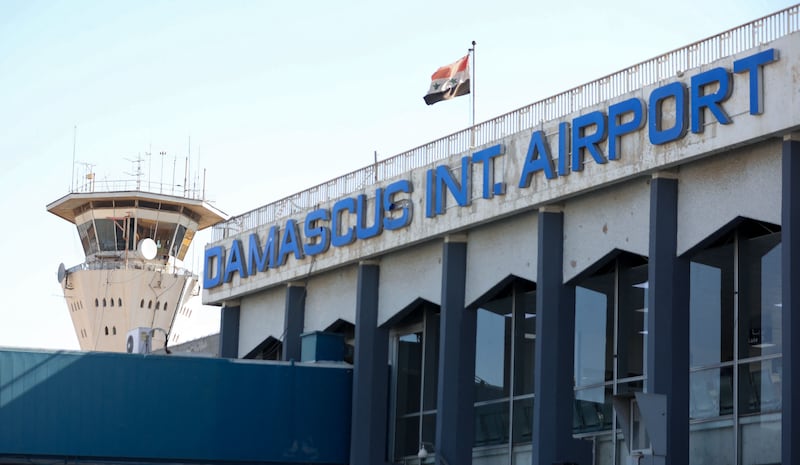An Israeli strike on Damascus airport on January 1 that killed two soldiers and shut the terminal for a short period appears to have caused more extensive damage than officials previously admitted, sources at the facility told The National.
Barely 24 hours into 2023, Israel carried out the year's first strikes on Syria having routinely hit what it says are Iranian arms shipments and threats to its security.
Syrian military sources said that Israel fired “several missiles towards Damascus International Airport, killing two soldiers and putting it out of service”.
Although the airport was back in service mere hours later — with improvised repairs — The National has learnt that the strikes were more serious than initially disclosed.
Damascus airport has two runways ― a northern one used mainly for civilian flights from the Syrian capital, and a southern runway that reports suggest is commonly used for weapons shipments from Iran.
While the civilian runway suffered less damage in the strikes, engineers were able to re-open the landing strip to allow flights to resume.
The southern runway, however, was hit by at least seven missiles, causing extensive damage.
Hours after the attack, Syria’s Transport Ministry said normal services had resumed and that the strikes caused no delays, save for a flight from Moscow being diverted to Latakia airport on the north-west coast.
“After the Israeli aggression, and in a record time, the maintenance workshops managed to remove debris from the runways and went on to conduct a successful engineering operation that sought to shorten the runway by 500 metres,” Director of Syrian Civil Aviation Bassem Mansour told local radio.
Satellite images of the airport taken since the attack appear to show damage to the northern runway as a strike crater about 500m from the north-east end. About 3,000m of the runway appears to be unaffected.
While Israel rarely discusses strikes it has carried out in Syria, it is believed to be behind dozens of operations in the country. Most are directed at Iranian and Hezbollah operatives, but some target Syrian military sites.
Damascus airport has become a frequent target to prevent shipments being flown in from Tehran.
“The reality is that the attacks are hitting the runways almost all the time, sometimes it's deliberately done as a warning, but like the attack last summer [June 2022] it was to paralyse traffic completely,” a member of the airport ground crew told The National.
“We managed to reduce the length of the runway, but sometimes real technical work needs time and materials, not everything is available to us.”
Syria is under heavy international sanctions, which block a lot of imported goods and materials.
The airport worker criticised Israel for targeting “civilian targets and terminals”, saying “this is a civilian airport at the end of the day, and it’s used by thousands of civilians daily”.
But the Aurora Intelligence group, which monitors the Syrian conflict closely, said “it was a significant strike designed to disable the southern runway which is known to be affiliated with the IRGC [Iranian Revolutionary Guard Corps] and their activities”.
The group said that while it is not true that the southern runway is exclusively used by Iran, it is “largely viewed that way because most of the activity there is due to IRGC affiliated movement”.
They added that the January 1 attack was “the largest single strike we’ve seen on a runway” but said that there were similar strikes in June 2022 and December 2021 targeting the runway as well as simultaneous strikes on Damascus and Aleppo in August last year.
“This was seven, possibly eight [missiles]. The strike impact intensity ultimately determines how long this runway is out of order, we’ve seen the authorities patch a runway in 72 hours, but have seen others take two to three months.”
Ruwan Rejoleh, an analyst in Washington who follows the Syrian war closely, said that Israel’s new government was unlikely to halt the policy of regular strikes on Syria.
“The new right-wing government in Israel is likely to continue with air strikes targeting Iranian backed and linked logistical targets such as Damascus airport, amongst others; this has been a continuous policy and will seemingly be implemented as well in 2023.”
Syria’s superpower patron Russia is becoming increasingly distant from the situation as it turns its focus more to its overstretched Ukraine front.
Syria’s ageing military equipment and antique air defences struggle to deter Israeli attacks or defend vital military infrastructure.
While Russia had an advanced S-300 air defence system in Syria, it rarely fired on Israeli planes and Moscow has since removed it from the country for use in Ukraine.
While Israel has not commented on the attack, it came just days before military chief Maj Gen Oded Basiuk presented the army’s operational outlook for 2023.
“We see that our course of action in Syria is an example of how continuous and persistent military action leads to shaping and influencing the entire region. We will not accept Hezbollah 2.0 in Syria,” the outlook reads.
“We are conducting an accelerated campaign between campaigns — and not only in Syria. To this end, we have carried out dozens of strikes with hundreds of armaments in the past year.”






